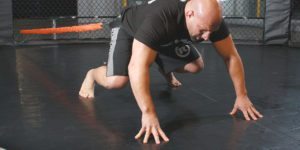Can you improve flexibility while watching TV?
- Training Team
- Flexibility, Injury Prevention
Strength, power, endurance, speed, fitness, skill. These are all essential components for successful rugby. If you are missing just one of these components, you will probably find yourself playing the position that no self-respecting rugger wants – left back. That’s left back in the locker room having been dropped from the team!
You can develop all of these components in the gym, and by following a well-designed training program.
However, there is one fitness component that a lot of ruggers ignore completely – flexibility. Flexibility training is not fun, it’s not sexy, and it’s not very “rugby”, but that doesn’t mean it’s not important. In fact, in many ways, flexibility underpins almost every other aspect of your rugby fitness.
Good flexibility can improve your rugby performance by increasing your functional range of movement. To sprint, you need to be able to stride out, and to reach out to make a crucial catch or tackle, you need great flexibility throughout your body.
Good flexibility can also reduce your risk of injury. You can think of it as pre-hab. Tight muscles are more prone to strains and pulls than flexible muscles – especially during activities that use a large range of motion. Want to be able to sprint without suffering groin and hamstring strains? You need to stretch more.
Despite being so important, most ruggers relegate flexibility training to a few minutes at the end of their workout, usually as part of their cool down. This is not a good way to increase your flexibility, and at best will maintain your current levels of inflexibility.
Like developing strength or power, improving your flexibility will take a concerted effort, and not just a few minutes after hitting the gym.
You don’t have to take up yoga to develop better flexibility, and nor do you need the flexibility of a gymnast, but you do need to stretch more often if you are going to improve this crucial fitness component.
As a young player, I was very prone to suffering hamstring strains. Hardly a month went past without me needing to take a break from training and games to let yet another pulled hammie heal. Fed up with spending yet more time on the injured list, I decided to prioritize stretching and flexibility by getting up 30 minutes earlier than usual, and stretching before heading off to work.
In just a few weeks, my dedication paid off, and the hamstring injuries that had previously plagued me all-but vanished. Once I had developed a decent level of flexibility, it was then easy to maintain.
This approach worked for me, but most ruggers need their sleep, so getting up 30 minutes earlier is not an attractive option. However, you can get all the benefits of doing regular dedicated flexibility training by stretching at another time of day – while watching TV. Stretching while watching TV is, in many ways, the perfect time to work on your flexibility.
- You’ll be distracted by whatever you are watching which will help cancel out much of the boredom most ruggers experience while stretching
- It’s relaxing so you’ll sleep better
- While you sleep, your muscles will repair and heal themselves in an elongated position, improving your flexibility faster
- You can use commercial ad breaks to time your stretches
- Stretching while watching TV breaks up long periods of sitting, which can be detrimental to flexibility and posture
- Getting up and moving, even just a little, will stimulate your metabolic rate, leading to less fat gain and, potentially, more fat loss if you are watching what you eat
How to stretch for better flexibility
Most ruggers don’t hold their stretches long enough to improve flexibility. That’s why a couple of minutes at the end of a workout is not enough, and your flexibility probably hasn’t increased in years.
To improve your flexibility, you need to hold your stretches for at least 30 seconds, and preferably longer. This allows the stretch reflex to kick in, which causes your muscles to relax so you can more into a deeper, more stretched position.
Stretching while watching TV provides the perfect opportunity to stretch a muscle for several minutes at a time. Holding a stretch for several minutes requires that you are comfortable, and how much more comfortable can you be than when you are sat on your couch watching TV?!
Follow this developmental stretching protocol to make sure you get the most out of your stretching efforts.
- Ease into your chosen stretch. Stretch until you can feel mild tension in the target muscle. This is called the point of bind. Hold this position without bouncing until you feel the muscle relax. This normally takes 20-30 seconds.
- As you feel your muscle relax, gently increase the stretch until you reach a new, deeper, point of bind. Again, hold for another 20-30 seconds until you feel the target muscle relax.
- Repeat this sequence until you feel you have reached your flexibility limit – usually 3-4 cycles.
Stop or reduce the stretch if you feel any burning, cramping, or your muscles start to shake. These sensations suggest you have stretched too far or too fast. Also, resist the temptation to bounce or pulse while you stretch, as this can disrupt the stretch reflex.
Which muscles to stretch?
A common flexibility mistake that most ruggers make is trying to stretch all their muscles equally. This makes stretching even more time-consuming than it needs to be. Instead, you should prioritize your time and energy by spending more time on your tight muscles, and less time on those that are not so important.
For example, most ruggers have tight hamstrings, hip flexors, and pecs. These are the muscles that deserve the most attention. Smaller, less crucial muscles like your biceps and triceps don’t need to be stretched for as long or as often. After all, if you can raise a beer glass up to your mouth, your triceps are probably as flexible as they need to be!
Instead of stretching every muscle from your feet to your head, focus on those muscles that are noticeably tight. You’ll probably be aware of what these muscles are already.
Not sure where to start? Here is a short but effective stretching routine that is perfect for most ruggers. And best of all, you can do it while seated on or very near to your couch and without looking away from your TV!
1. Seated hamstring stretch
Tight hammies can cause a lot of problems – from lower back pain to frequent hamstring strains. Solve this problem from the comfort of your couch with this easy stretch. Make sure to hinge from the hips rather than round your back for best results.
Check out this video to see how to do this exercise:
2. Kneeling hip flexor stretch
Also known as the runner’s lunge, this is a great stretch for the muscles in the front of your hip. Long periods of sitting can leave these muscles short and tight, leading to back pain and reduced sporting performance. Make this exercise more challenging by elevating your rear foot. Keep things comfortable by placing a couch cushion under your supporting knee.
Watch this video to see the right and the wrong way to do this crucial stretch:
3. Seated adductor stretch
Tight adductor or grain muscles are easily injured. Very few gym-based exercises take these muscles through anything like their full range of motion. For this reason, they should always be on your stretching to-do list.
Here is a couch-friendly way to stretch your adductors:
4. Seated piriformis stretch
The piriformis muscle is located in your buttocks, and is so commonly tight that it has a syndrome named after it. Piriformis syndrome can cause pain in your lower back, hip, and may even radiate down your leg.
Check out this easy piriformis stretch:
5. Seated chest stretch
Countless sets of push-ups and bench presses can leave you with tight pecs. Tight pecs can ruin your posture, and interfere with proper shoulder movement, leading to pain and injury.
Stretch your pecs with this easy seated exercise:
If you want to improve your flexibility, you need to stretch regularly, and that means making stretching habitual. The trick to creating a new habit is to attach it to an existing habit – in this instance, watching TV. The next time you sit down to watch TV, spend at least some of that downtime working on your flexibility.
In time, you won’t even have to think about stretching; it’ll just become something you do whenever you watch TV. Don’t forget to enhance your recovery while you sleep by chugging a Rugby Whey protein shake before heading off to bed.


